Quantifying Mining-Induced Phenological Disturbance and Soil Moisture Regulation in Semi-Arid Grasslands Using HLS Time Series
Abstract
1. Introduction
2. Study Area and Data Sources
2.1. Study Area
2.2. Data Sources and Preprocessing
3. Research Methodology
3.1. Construction of Initial Vegetation Index Time Series Dataset
3.2. Vegetation Index Time Series Reconstruction
3.2.1. Savitzky–Golay Filtering
3.2.2. Double Logistic Fitting
3.2.3. Asymmetric Gaussian Fitting
3.3. Extraction of Vegetation Phenology Parameters
3.4. Quantitative Method for Assessing the Impact of Mining Activities on Vegetation Phenology
4. Results and Analysis
4.1. Comparison of Time Series Reconstruction Methods
4.2. Delineation of the Impact Range of Mining Activities
4.3. Sensitivity Analysis of Vegetation Indices to Mining Activities
4.4. The Effect of Soil Moisture Content on Vegetation Phenology
5. Discussion
5.1. Analysis of Sensitivity Differences in Vegetation Indexes Under Mining Activities
5.2. Analysis of Phenological Variations in Mining Areas and Influencing Factors
- (1)
- Following large-scale coal extraction, the overlying strata undergo displacement, bending and deformation due to loss of support, ultimately forming subsidence basins and tensile fissures at the surface. Surface subsidence and fissures constitute the primary physical pathways for soil moisture loss [73]. Compared to undisturbed areas, subsidence zones exhibit significantly reduced soil bulk density and markedly increased porosity [74]. This alteration in soil physical structure substantially diminishes its water-holding capacity. Furthermore, by providing rapid pathways for surface water and precipitation, the vertical extension of surface fissures reduces surface runoff and effective infiltration, thereby intensifying water evaporation from the increased soil surface area. This physical water loss directly causes a sharp decline in surface soil moisture content, imposing severe water stress on vegetation [75].
- (2)
- Beyond direct surface impacts, large-scale underground mining has caused fundamental disruption to regional hydrogeological systems. Mining activities have compromised the integrity of aquifer systems, particularly shallow alluvial aquifers, leading to reduced aquifer pressure and hydrogeophysical leakage [76]. These alterations to the hydrogeological structure have altered groundwater flow pathways and may disrupt groundwater recharge sources. The substantial decline in groundwater levels induced by mining constitutes a key factor in vegetation water scarcity within semi-arid regions [77]. As native vegetation in these areas relies heavily on groundwater for survival, falling water tables directly sever deep-water supply sources to vegetation, triggering cascading effects on growth, spatial distribution and community succession processes. Case studies from other regions globally corroborate this perspective. For instance, mining-induced droughts have led to substantial reductions in groundwater reserves surrounding mining areas, resulting in a marked decline in vegetation community indicators [78,79,80].
- (3)
- In addition to alterations in physical structure and hydrological conditions, mining activities may induce changes in the physicochemical properties of surface soils [81], thereby further exacerbating vegetation stress. Although the physicochemical characteristics of surface soils vary across different subsidence areas, these alterations may indirectly affect vegetation growth by influencing soil nutrient availability and ionic equilibrium [82,83,84]. For instance, salts and heavy metals from mining waste may enter surrounding soils via runoff or seepage, leading to soil salinization or excessive heavy metal concentrations, thereby exerting toxic effects on vegetation physiology [85]. However, systematic research examining the interplay between different coal-mine subsidence patterns and soil physicochemical properties remains scarce and fragmented, highlighting topics that require further investigation in future studies.
5.3. Limitations and Future Work
6. Conclusions
Author Contributions
Funding
Data Availability Statement
Conflicts of Interest
References
- Florea, S. ‘The Green, Green Grass of Home’; an Eco Linguistic Analysis of the Environmental Responsibility Urban Discourse of Europe’s Most Polluted Cities. J. Environ. Manag. 2025, 392, 126718. [Google Scholar] [CrossRef]
- Abuodha, J.O.Z.; Hayombe, P.O. Protracted Environmental Issues on a Proposed Titanium Minerals Development in Kenya’s South Coast. Mar. Georesources Geotechnol. 2006, 24, 63–75. [Google Scholar] [CrossRef]
- Mundaca, G. Economic Valuation of Environmental and Health Impacts from Mining: The Case of Peru. Environ. Dev. Sustain 2022, 26, 2415–2441. [Google Scholar] [CrossRef]
- Statistical Review of World Energy 2022. Available online: https://www.bp.com/en/global/corporate/energy-economics/statistical-review-of-world-energy.html (accessed on 19 September 2025).
- Mhaske, S.N.; Pathak, K.; Dash, S.S.; Nayak, D.B. Assessment and Management of Soil Erosion in the Hilltop Mining Dominated Catchment Using GIS Integrated RUSLE Model. J. Environ. Manag. 2021, 294, 112987. [Google Scholar] [CrossRef] [PubMed]
- Saedpanah, S.; Amanollahi, J. Environmental Pollution and Geo-Ecological Risk Assessment of the Qhorveh Mining Area in Western Iran. Environ. Pollut. 2019, 253, 811–820. [Google Scholar] [CrossRef] [PubMed]
- Shen, Z.; Zhang, Q.; Chen, D.; Singh, V.P. Varying Effects of Mining Development on Ecological Conditions and Groundwater Storage in Dry Region in Inner Mongolia of China. J. Hydrol. 2021, 597, 125759. [Google Scholar] [CrossRef]
- Owusu, E.H.; Ofori, B.Y.; Attuquayefio, D.K. The Secondary Impact of Mining on Primates and Other Medium to Large Mammals in Forest Reserves in Southwestern Ghana. Extr. Ind. Soc. 2018, 5, 114–121. [Google Scholar] [CrossRef]
- Huang, H.; Zheng, X.; Tao, S.; Ma, S.; Feng, S.; Li, Y.; Liang, K.; Li, G.; Lei, J.; Liu, H.; et al. Adaptive Mechanisms of Moss (Campylopus schmidii) to Cr(Ⅵ) Stress in Pyrite-Mining Polluted Ecosystems: Integrating Biochemical, Structural, and Molecular Perspectives. Environ. Pollut. 2025, 382, 126708. [Google Scholar] [CrossRef]
- Feng, H.; Zhou, J.; Zhou, A.; Su, D.; Han, X.; Xiong, R. Co-Evolution Mechanism of Grassland Degradation and Its Belowground Habitat under the Influence of Coal Mining Activities. Catena 2024, 241, 107997. [Google Scholar] [CrossRef]
- Zhao, D.; Wang, Z.; Wu, X.; Qiu, T. Response of Vegetation Dynamics in Environmentally Sensitive and Fragile Areas to Natural and Anthropogenic Factors: A Case Study in Inner Mongolia Autonomous Region, China. Anthropocene 2023, 44, 100414. [Google Scholar] [CrossRef]
- Song, D.; Hu, Z.; Zeng, J.; Sun, H. Influence of Mining on Vegetation in Semi-Arid Areas of Western China Based on the Coupling of above Ground and below Ground—A Case Study of Daliuta Coalfield. Ecol. Indic. 2024, 161, 111964. [Google Scholar] [CrossRef]
- Ren, H.; Zhao, Y.; Xiao, W.; Zhang, L. Unmanned Aerial Vehicle (UAV)-Based Vegetation Restoration Monitoring in Coal Waste Dumps after Reclamation. Remote Sens. 2024, 16, 881. [Google Scholar] [CrossRef]
- Lee, B.R.; Ibáñez, I. Spring Phenological Escape Is Critical for the Survival of Temperate Tree Seedlings. Funct. Ecol. 2021, 35, 1848–1861. [Google Scholar] [CrossRef]
- Lu, Q.; Zhao, D.; Wu, S.; Dai, E.; Gao, J. Using the NDVI to Analyze Trends and Stability of Grassland Vegetation Cover in Inner Mongolia. Theor. Appl. Climatol. 2019, 135, 1629–1640. [Google Scholar] [CrossRef]
- Zhou, Y.; Liu, F.; Zhang, G.; Wang, J. Response of the Normalized Difference Vegetation Index (NDVI) to Snow Cover Changes on the Qinghai–Tibet Plateau. Remote Sens. 2024, 16, 2140. [Google Scholar] [CrossRef]
- Bounouh, O.; Essid, H.; Tarquis, A.M.; Farah, I.R. Phenology as Accuracy Metrics for Vegetation Index Forecasting over Tunisian Forest and Cereal Cover Types. Int. J. Remote Sens. 2021, 42, 4644–4671. [Google Scholar] [CrossRef]
- Anees, S.A.; Mehmood, K.; Rehman, A.; Rehman, N.U.; Muhammad, S.; Shahzad, F.; Hussain, K.; Luo, M.; Alarfaj, A.A.; Alharbi, S.A.; et al. Unveiling Fractional Vegetation Cover Dynamics: A Spatiotemporal Analysis Using MODIS NDVI and Machine Learning. Environ. Sustain. Indic. 2024, 24, 100485. [Google Scholar] [CrossRef]
- Sidi Almouctar, M.A.; Wu, Y.; Kumar, A.; Zhao, F.; Mambu, K.J.; Sadek, M. Spatiotemporal Analysis of Vegetation Cover Changes around Surface Water Based on NDVI: A Case Study in Korama Basin, Southern Zinder, Niger. Appl. Water Sci. 2021, 11, 4. [Google Scholar] [CrossRef]
- Xu, Z.; Li, Y.; Li, B.; Hao, Z.; Lin, L.; Hu, X.; Zhou, X.; Yu, H.; Xiang, S.; Pascal, M.-L.-F.; et al. A Comparative Study on the Applicability and Effectiveness of NSVI and NDVI for Estimating Fractional Vegetation Cover Based on Multi-Source Remote Sensing Image. Geocarto Int. 2023, 38, 2184501. [Google Scholar] [CrossRef]
- Zheng, K.; Wei, J.-Z.; Pei, J.-Y.; Cheng, H.; Zhang, X.-L.; Huang, F.-Q.; Li, F.-M.; Ye, J.-S. Impacts of Climate Change and Human Activities on Grassland Vegetation Variation in the Chinese Loess Plateau. Sci. Total Environ. 2019, 660, 236–244. [Google Scholar] [CrossRef]
- Senf, C.; Pflugmacher, D.; Heurich, M.; Krueger, T. A Bayesian Hierarchical Model for Estimating Spatial and Temporal Variation in Vegetation Phenology from Landsat Time Series. Remote Sens. Environ. 2017, 194, 155–160. [Google Scholar] [CrossRef]
- Gao, F.; Hilker, T.; Zhu, X.; Anderson, M.; Masek, J.; Wang, P.; Yang, Y. Fusing Landsat and MODIS Data for Vegetation Monitoring. IEEE Geosci. Remote Sens. Mag. 2015, 3, 47–60. [Google Scholar] [CrossRef]
- Zhao, W.; Qu, Y.; Chen, J.; Yuan, Z. Deeply Synergistic Optical and SAR Time Series for Crop Dynamic Monitoring. Remote Sens. Environ. 2020, 247, 111952. [Google Scholar] [CrossRef]
- Ju, J.; Zhou, Q.; Freitag, B.; Roy, D.P.; Zhang, H.K.; Sridhar, M.; Mandel, J.; Arab, S.; Schmidt, G.; Crawford, C.J.; et al. The Harmonized Landsat and Sentinel-2 Version 2.0 Surface Reflectance Dataset. Remote Sens. Environ. 2025, 324, 114723. [Google Scholar] [CrossRef]
- Bao, G. Mongolian Pines (Pinus sylvestris var. mongolica) in the Hulun Buir Steppe, China, Respond to Climate in Adjustment to the Local Water Supply. Int. J. Biometeorol. 2015, 59, 1–10. [Google Scholar] [CrossRef] [PubMed]
- Wang, S.; Huang, J.; Yu, H.; Ji, C. Recognition of Landscape Key Areas in a Coal Mine Area of a Semi-Arid Steppe in China: A Case Study of Yimin Open-Pit Coal Mine. Sustainability 2020, 12, 2239. [Google Scholar] [CrossRef]
- Zhang, C.; Zhang, Y.; Li, J. Grassland Productivity Response to Climate Change in the Hulunbuir Steppes of China. Sustainability 2019, 11, 6760. [Google Scholar] [CrossRef]
- Fensholt, R.; Sandholt, I.; Stisen, S. Evaluating MODIS, MERIS, and VEGETATION Vegetation Indices Using in Situ Measurements in a Semiarid Environment. IEEE Trans. Geosci. Remote Sens. 2006, 44, 1774–1786. [Google Scholar] [CrossRef]
- Da Silva, P.C.; Ribeiro Junior, W.Q.; Ramos, M.L.G.; Lopes, M.F.; Santana, C.C.; Casari, R.A.D.C.N.; Brasileiro, L.D.O.; Veiga, A.D.; Rocha, O.C.; Malaquias, J.V.; et al. Multispectral Images for Drought Stress Evaluation of Arabica Coffee Genotypes Under Different Irrigation Regimes. Sensors 2024, 24, 7271. [Google Scholar] [CrossRef]
- Gitelson, A.A.; Gritz †, Y.; Merzlyak, M.N. Relationships between Leaf Chlorophyll Content and Spectral Reflectance and Algorithms for Non-Destructive Chlorophyll Assessment in Higher Plant Leaves. J. Plant Physiol. 2003, 160, 271–282. [Google Scholar] [CrossRef]
- Qi, J.; Chehbouni, A.; Huete, A.R.; Kerr, Y.H.; Sorooshian, S. A Modified Soil Adjusted Vegetation Index. Remote Sens. Environ. 1994, 48, 119–126. [Google Scholar] [CrossRef]
- Meneses-Tovar, C.L. NDVI as Indicator of Degradation. Unasylva 2011, 62, 39–46. [Google Scholar]
- Chen, J.; Jönsson, P.; Tamura, M.; Gu, Z.; Matsushita, B.; Eklundh, L. A Simple Method for Reconstructing a High-Quality NDVI Time-Series Data Set Based on the Savitzky–Golay Filter. Remote Sens. Environ. 2004, 91, 332–344. [Google Scholar] [CrossRef]
- Yang, Y.; Luo, J.; Huang, Q.; Wu, W.; Sun, Y. Weighted Double-Logistic Function Fitting Method for Reconstructing the High-Quality Sentinel-2 NDVI Time Series Data Set. Remote Sens. 2019, 11, 2342. [Google Scholar] [CrossRef]
- Hui, C. Remote Sensing Image Denoising Algorithm Based on Asymmetric Gaussian Mixture Model. AAM 2024, 13, 4975–4989. [Google Scholar] [CrossRef]
- Miglani, A.; Ray, S.S.; Vashishta, D.P.; Parihar, J.S. Comparison of Two Data Smoothing Techniques for Vegetation Spectra Derived From EO-1 Hyperion. J. Indian Soc. Remote Sens. 2011, 39, 443–453. [Google Scholar] [CrossRef]
- Yu, L.; Liu, T.; Bu, K.; Yan, F.; Yang, J.; Chang, L.; Zhang, S. Monitoring the Long Term Vegetation Phenology Change in Northeast China from 1982 to 2015. Sci. Rep. 2017, 7, 14770. [Google Scholar] [CrossRef]
- Jonsson, P.; Eklundh, L. Seasonality Extraction by Function Fitting to Time-Series of Satellite Sensor Data. IEEE Trans. Geosci. Remote Sens. 2002, 40, 1824–1832. [Google Scholar] [CrossRef]
- Cheng, W.-C.; Chang, J.-C.; Chang, C.-P.; Su, Y.; Tu, T.-M. A Fixed-Threshold Approach to Generate High-Resolution Vegetation Maps for IKONOS Imagery. Sensors 2008, 8, 4308–4317. [Google Scholar] [CrossRef]
- White, M.A.; Nemani, R.R. Real-Time Monitoring and Short-Term Forecasting of Land Surface Phenology. Remote Sens. Environ. 2006, 104, 43–49. [Google Scholar] [CrossRef]
- Xiong, T.; Du, S.; Zhang, X.; Zhang, H.; Zhao, J. An Increasing Delay in Vegetation Spring Phenology over Northern Snow-Covered Landmass Driven by Temperature and Snowmelt. Agric. For. Meteorol. 2025, 361, 110310. [Google Scholar] [CrossRef]
- Hou, X.; Gao, S.; Niu, Z.; Xu, Z. Extracting Grassland Vegetation Phenology in North China Based on Cumulative SPOT-VEGETATION NDVI Data. Int. J. Remote Sens. 2014, 35, 3316–3330. [Google Scholar] [CrossRef]
- Ivits, E.; Cherlet, M.; Tóth, G.; Sommer, S.; Mehl, W.; Vogt, J.; Micale, F. Combining Satellite Derived Phenology with Climate Data for Climate Change Impact Assessment. Glob. Planet. Change 2012, 88–89, 85–97. [Google Scholar] [CrossRef]
- Behrenfeld, M.J. Abandoning Sverdrup’s Critical Depth Hypothesis on Phytoplankton Blooms. Ecology 2010, 91, 977–989. [Google Scholar] [CrossRef] [PubMed]
- Sun, X.; Yuan, L.; Liu, M.; Liang, S.; Li, D.; Liu, L. Quantitative Estimation for the Impact of Mining Activities on Vegetation Phenology and Identifying Its Controlling Factors from Sentinel-2 Time Series. Int. J. Appl. Earth Obs. Geoinf. 2022, 111, 102814. [Google Scholar] [CrossRef]
- Zhang, B.; Tan, X.; Wang, S.; Chen, M.; Chen, S.; Ren, T.; Xia, J.; Bai, Y.; Huang, J.; Han, X. Asymmetric Sensitivity of Ecosystem Carbon and Water Processes in Response to Precipitation Change in a Semi-arid Steppe. Funct. Ecol. 2017, 31, 1301–1311. [Google Scholar] [CrossRef]
- Gross, N.; Robson, T.M.; Lavorel, S.; Albert, C.; Le Bagousse-Pinguet, Y.; Guillemin, R. Plant Response Traits Mediate the Effects of Subalpine Grasslands on Soil Moisture. New Phytol. 2008, 180, 652–662. [Google Scholar] [CrossRef]
- D’Odorico, P.; Caylor, K.; Okin, G.S.; Scanlon, T.M. On Soil Moisture–Vegetation Feedbacks and Their Possible Effects on the Dynamics of Dryland Ecosystems. J. Geophys. Res. 2007, 112, 2006JG000379. [Google Scholar] [CrossRef]
- Xia, Y.Q.; Shao, M.A. Soil Water Carrying Capacity for Vegetation: A Hydrologic and Biogeochemical Process Model Solution. Ecol. Model. 2008, 214, 112–124. [Google Scholar] [CrossRef]
- Ma, T.; Tang, F.; Tang, J.; Wang, F.; Li, P.; Yang, Q.; Wang, S.; Jia, X. Effect of Coal Mining on Soil Moisture in the Semi-Arid Area Based on an Improved Remote Sensing Estimation Approach. Environ. Earth Sci. 2023, 82, 545. [Google Scholar] [CrossRef]
- Zhang, K.; Yang, K.; Wu, X.; Bai, L.; Zhao, J.; Zheng, X. Effects of Underground Coal Mining on Soil Spatial Water Content Distribution and Plant Growth Type in Northwest China. ACS Omega 2022, 7, 18688–18698. [Google Scholar] [CrossRef] [PubMed]
- Zhang, K.; Chen, M.; Feng, S.; Chen, X.; Yan, Z. Effects of Coal Mining Disturbance on Spatial and Temporal Distribution of Soil Water Content in Northwest China-based on 3D EBK Model. Hydrol. Process. 2024, 38, e15277. [Google Scholar] [CrossRef]
- Qian, D.; Yan, C.; Xiu, L.; Feng, K. The Impact of Mining Changes on Surrounding Lands and Ecosystem Service Value in the Southern Slope of Qilian Mountains. Ecol. Complex. 2018, 36, 138–148. [Google Scholar] [CrossRef]
- Xie, L.; Wu, W.; Huang, X.; Ou, P.; Lin, Z.; Zhiling, W.; Song, Y.; Lang, T.; Huangfu, W.; Zhang, Y.; et al. Mining and Restoration Monitoring of Rare Earth Element (REE) Exploitation by New Remote Sensing Indicators in Southern Jiangxi, China. Remote Sens. 2020, 12, 3558. [Google Scholar] [CrossRef]
- Vorovencii, I. Changes Detected in the Extent of Surface Mining and Reclamation Using Multitemporal Landsat Imagery: A Case Study of Jiu Valley, Romania. Environ. Monit. Assess. 2021, 193, 30. [Google Scholar] [CrossRef]
- Wang, X.; Xu, Z.; Li, Z.; Pan, D.; Li, H. Integrated Multiple Tracer-Based Tomographic Inversion and Heterogeneity Characterization of Karst Limestone Mining Regions in Southwest China. Int. J. Rock Mech. Min. Sci. 2024, 175, 105670. [Google Scholar] [CrossRef]
- Antoniadis, V.; Levizou, E.; Shaheen, S.M.; Ok, Y.S.; Sebastian, A.; Baum, C.; Prasad, M.N.V.; Wenzel, W.W.; Rinklebe, J. Trace Elements in the Soil-Plant Interface: Phytoavailability, Translocation, and Phytoremediation–A Review. Earth-Sci. Rev. 2017, 171, 621–645. [Google Scholar] [CrossRef]
- Shtangeeva, I.; Niemelä, M.; Perämäki, P.; Popov, A.; Vesavaara, I.; Suvela, R. Response of Wheat and Barley Seedlings on Soil Contamination with Bromides. Environ. Geochem. Health 2022, 44, 537–550. [Google Scholar] [CrossRef]
- Adamu, B.; Tansey, K.; Ogutu, B. An Investigation into the Factors Influencing the Detectability of Oil Spills Using Spectral Indices in an Oil-Polluted Environment. Int. J. Remote Sens. 2016, 37, 2338–2357. [Google Scholar] [CrossRef]
- Sun, Z.; Xie, X.; Wang, P.; Hu, Y.; Cheng, H. Heavy Metal Pollution Caused by Small-Scale Metal Ore Mining Activities: A Case Study from a Polymetallic Mine in South China. Sci. Total Environ. 2018, 639, 217–227. [Google Scholar] [CrossRef]
- Chintapenta, L.K.; Ommanney, K.I.; Ozbay, G. Presence and Plant Uptake of Heavy Metals in Tidal Marsh Wetland Soils. Front. Public Health 2022, 10, 821892. [Google Scholar] [CrossRef]
- Du, N.; Guo, W.; Zhang, X.; Wang, R. Morphological and Physiological Responses of Vitex negundo L. var. heterophylla (Franch.) Rehd. to Drought Stress. Acta Physiol. Plant. 2010, 32, 839–848. [Google Scholar] [CrossRef]
- Li, M.; Wang, W.; Li, H.; Yang, Z.; Li, J. Monitoring of Vegetation Chlorophyll Content in Photovoltaic Areas Using UAV-Mounted Multispectral Imaging. Front. Plant Sci. 2025, 16, 1643945. [Google Scholar] [CrossRef]
- Qiu, B.; Zeng, C.; Tang, Z.; Chen, C. Characterizing Spatiotemporal Non-Stationarity in Vegetation Dynamics in China Using MODIS EVI Dataset. Environ. Monit. Assess. 2013, 185, 9019–9035. [Google Scholar] [CrossRef] [PubMed]
- Laneve, G.; Castronuovo, M.M. Comparison between Vegetation Change Analysis in Kenya Based on AVHRR and SeaWiFS Images. Int. J. Remote Sens. 2005, 26, 2549–2559. [Google Scholar] [CrossRef]
- Guo, G.; Wang, J.; Zhao, S.; Zhang, C. Interactions of Cross-Diffusion and Nonlocal Delay Induce Spatial Vegetation Patterning in Semi-Arid Environments. Nonlinear Dyn. 2024, 112, 11615–11636. [Google Scholar] [CrossRef]
- Luo, H.; Dai, S.; Li, M.; Liu, E.; Li, Y.; Xie, Z. NDVI-Based Analysis of the Influence of Climate Changes and Human Activities on Vegetation Variation on Hainan Island. J. Indian Soc. Remote Sens. 2021, 49, 1755–1767. [Google Scholar] [CrossRef]
- Kang, W.; Wang, T.; Liu, S. The Response of Vegetation Phenology and Productivity to Drought in Semi-Arid Regions of Northern China. Remote Sens. 2018, 10, 727. [Google Scholar] [CrossRef]
- Wang, C.; Wang, H.; Yuan, S. Precipitation Governing Vegetation Patterns in an Arid or Semi-Arid Environment. J. Math. Biol. 2023, 87, 22. [Google Scholar] [CrossRef]
- Luo, M.; Meng, F.; Sa, C.; Duan, Y.; Bao, Y.; Liu, T.; De Maeyer, P. Response of Vegetation Phenology to Soil Moisture Dynamics in the Mongolian Plateau. Catena 2021, 206, 105505. [Google Scholar] [CrossRef]
- Ren, S.; Li, Y.; Peichl, M. Diverse Effects of Climate at Different Times on Grassland Phenology in Mid-Latitude of the Northern Hemisphere. Ecol. Indic. 2020, 113, 106260. [Google Scholar] [CrossRef]
- Song, Z.; Zhang, J.; Chi, M.; Guo, N.; Yang, S.; Guo, Y.; He, R.; Gao, Z. The Influence of the Morphological Characteristics of Mining-Induced Ground Fissures on the Spatiotemporal Distribution of Soil Moisture. Water 2024, 16, 2496. [Google Scholar] [CrossRef]
- Zhang, Y.; Gong, H.; Gu, Z.; Wang, R.; Li, X.; Zhao, W. Characterization of Land Subsidence Induced by Groundwater Withdrawals in the Plain of Beijing City, China. Hydrogeol. J. 2014, 22, 397–409. [Google Scholar] [CrossRef]
- Li, J.; Wu, L.; Huang, Y.; Hu, B.; Wu, X.; Cao, G. Characteristics of Soil Moisture Transport in the Aeration Zone of Subsidence Areas under the Disturbance of Coal Seam Mining. Geomech. Geophys. Geo-Energ. Geo-Resour. 2024, 10, 151. [Google Scholar] [CrossRef]
- Wang, C.; Liao, F.; Wang, G.; Qu, S.; Mao, H.; Bai, Y. Hydrogeochemical Evolution Induced by Long-Term Mining Activities in a Multi-Aquifer System in the Mining Area. Sci. Total Environ. 2023, 854, 158806. [Google Scholar] [CrossRef] [PubMed]
- Li, C.; Gao, X.; Xiang, X.; Jiang, C.; Duan, Y.; Wang, W.; Zhang, X.; Tan, T.; Wang, Q.; Wang, Y. Intense Human Activities Induce the Dynamic Changes of Interaction Pattern Between Karst Water-Quaternary Groundwater in the Basin-Mountain Coupling Belt Over the Past 60 Years. Water Resour. Res. 2024, 60, e2023WR035211. [Google Scholar] [CrossRef]
- Zhou, S.; Zhang, Y. Open-Pit Coal Mining Alters Vegetation Cover, Soil Microbial Metabolic Profile and Nutrient Cycling Potential in an Arid Shrubland. J. Environ. Chem. Eng. 2025, 13, 118804. [Google Scholar] [CrossRef]
- Różkowski, J.; Rahmonov, O.; Szymczyk, A. Environmental Transformations in the Area of the Kuźnica Warężyńska Sand Mine, Southern Poland. Land 2020, 9, 116. [Google Scholar] [CrossRef]
- Chen, Z.; Zhang, X.; Jiao, Y.; Cheng, Y.; Zhu, Z.; Wang, S.; Zhang, H. Investigating the Spatio-Temporal Pattern Evolution Characteristics of Vegetation Change in Shendong Coal Mining Area Based on kNDVI and Intensity Analysis. Front. Ecol. Evol. 2023, 11, 1344664. [Google Scholar] [CrossRef]
- Peng, S.; Bao, N.; Zhao, X.; Meng, D.; Han, Z. How Soil Physicochemical Properties and Microorganisms Change under Mining Activities in Alpine and High-Altitude Regions−A Case Study of a Copper Mine Area in Tibet Plateau. J. Environ. Chem. Eng. 2025, 13, 117202. [Google Scholar] [CrossRef]
- Xu, R.; Li, J.; Li, X.; Song, W. Effect of Coal Mining Subsidence on Soil Microbial Communities in Mining Areas with High Groundwater Levels. Environ. Geochem. Health 2025, 47, 245. [Google Scholar] [CrossRef]
- Sun, J.; Yang, L.; Wei, J.; Quan, J.; Yang, X. The Responses of Soil Bacterial Communities and Enzyme Activities to the Edaphic Properties of Coal Mining Areas in Central China. PLoS ONE 2020, 15, e0231198. [Google Scholar] [CrossRef]
- Huang, L.; Xu, C.; Xu, J.; Zhao, Y. Hydrate Dissociation Evaluation and Stratum Subsidence Response Induced by Depressurization in Hydrate-Bearing Permafrost. Energy Fuels 2022, 36, 11077–11088. [Google Scholar] [CrossRef]
- Yang, Q.W.; Shu, W.S.; Qiu, J.W.; Wang, H.B.; Lan, C.Y. Lead in Paddy Soils and Rice Plants and Its Potential Health Risk around Lechang Lead/Zinc Mine, Guangdong, China. Environ. Int. 2004, 30, 883–889. [Google Scholar] [CrossRef]
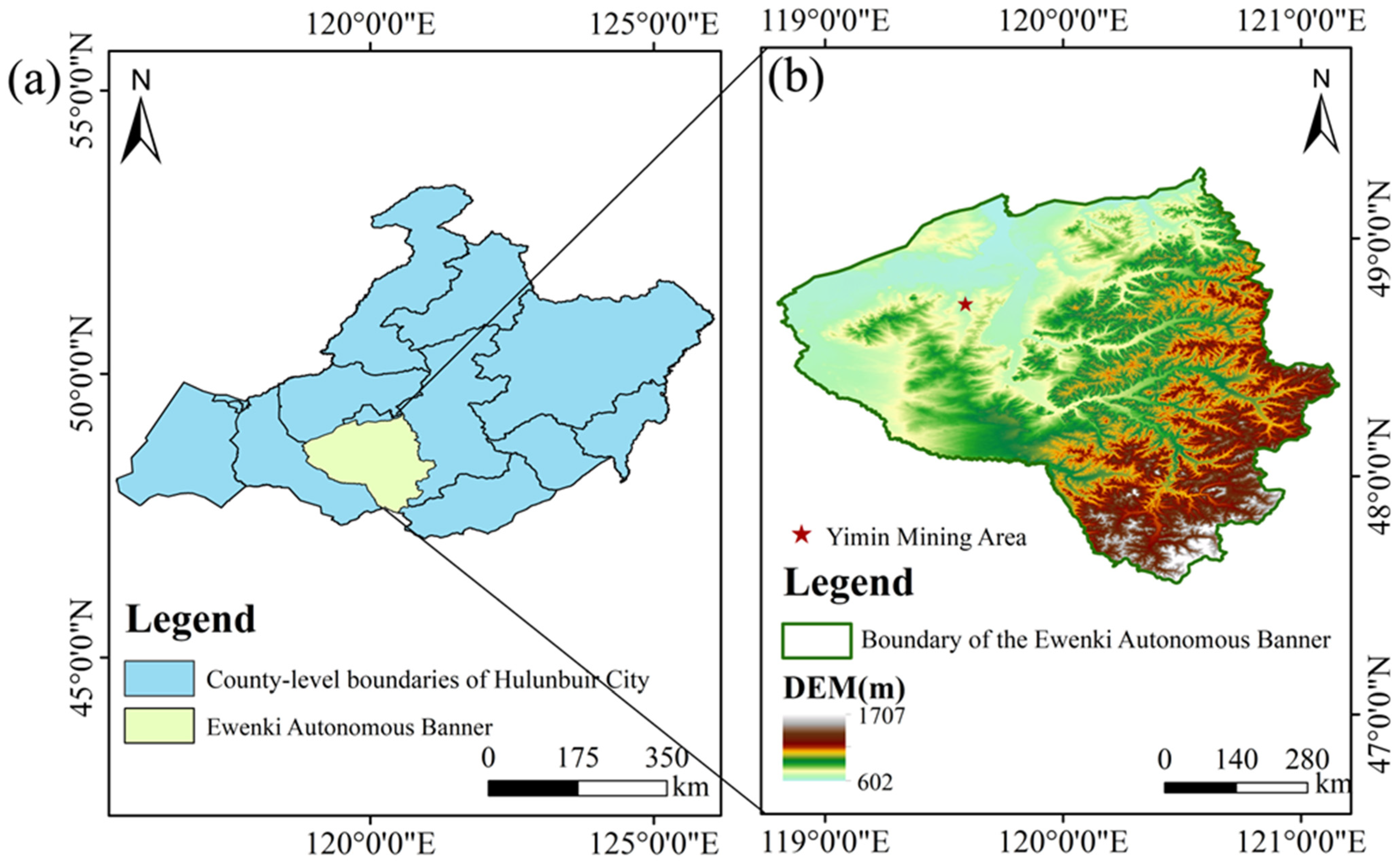
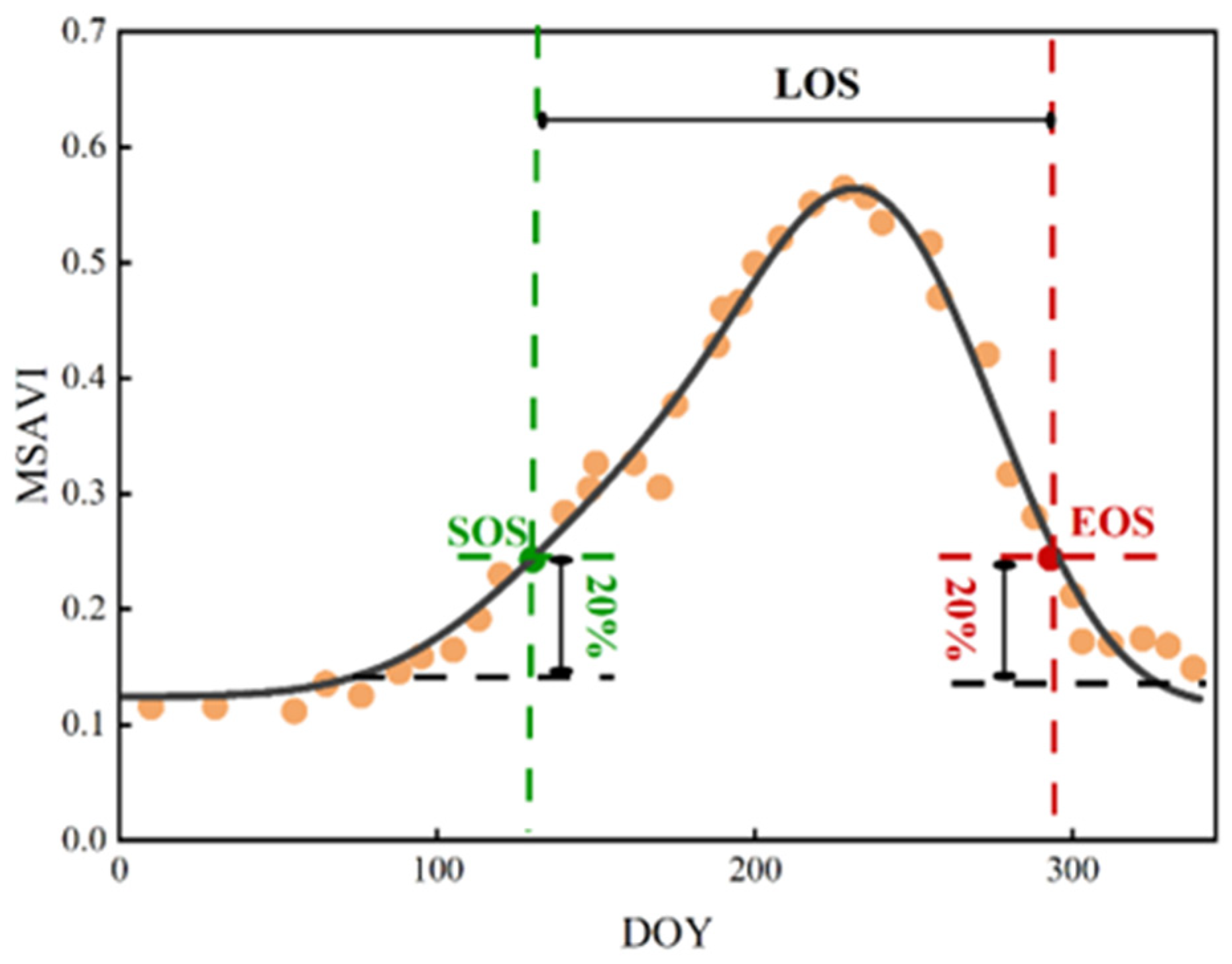
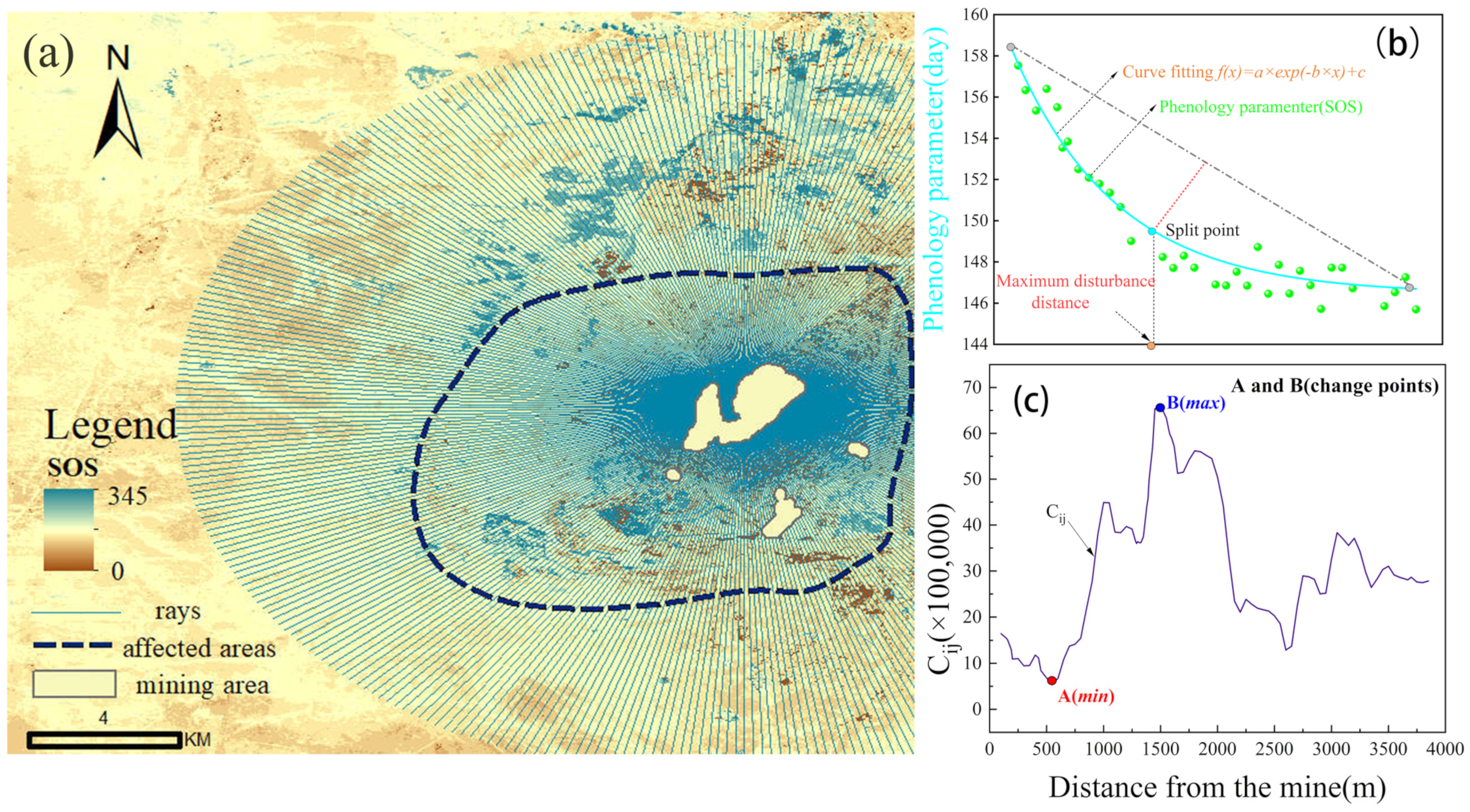

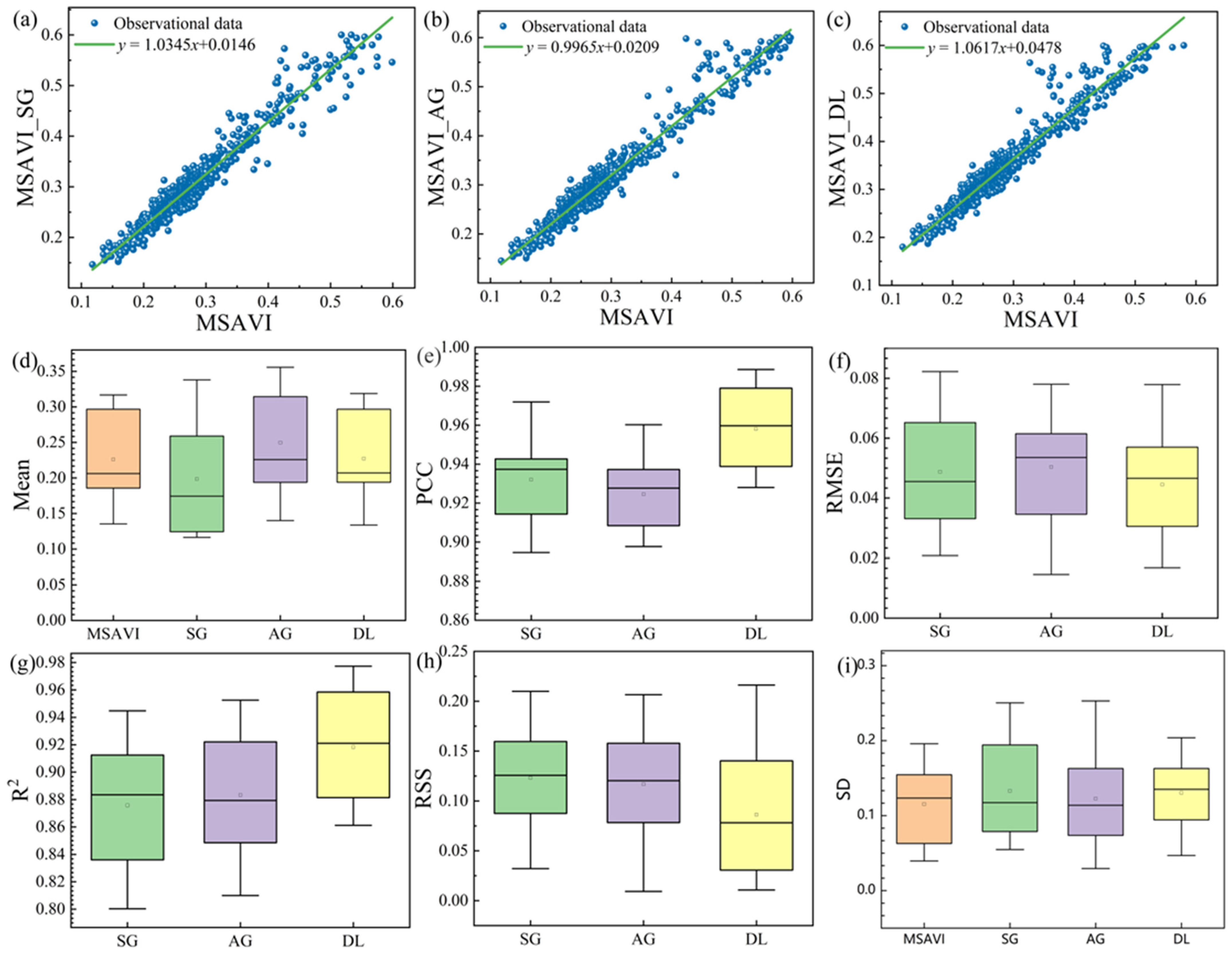

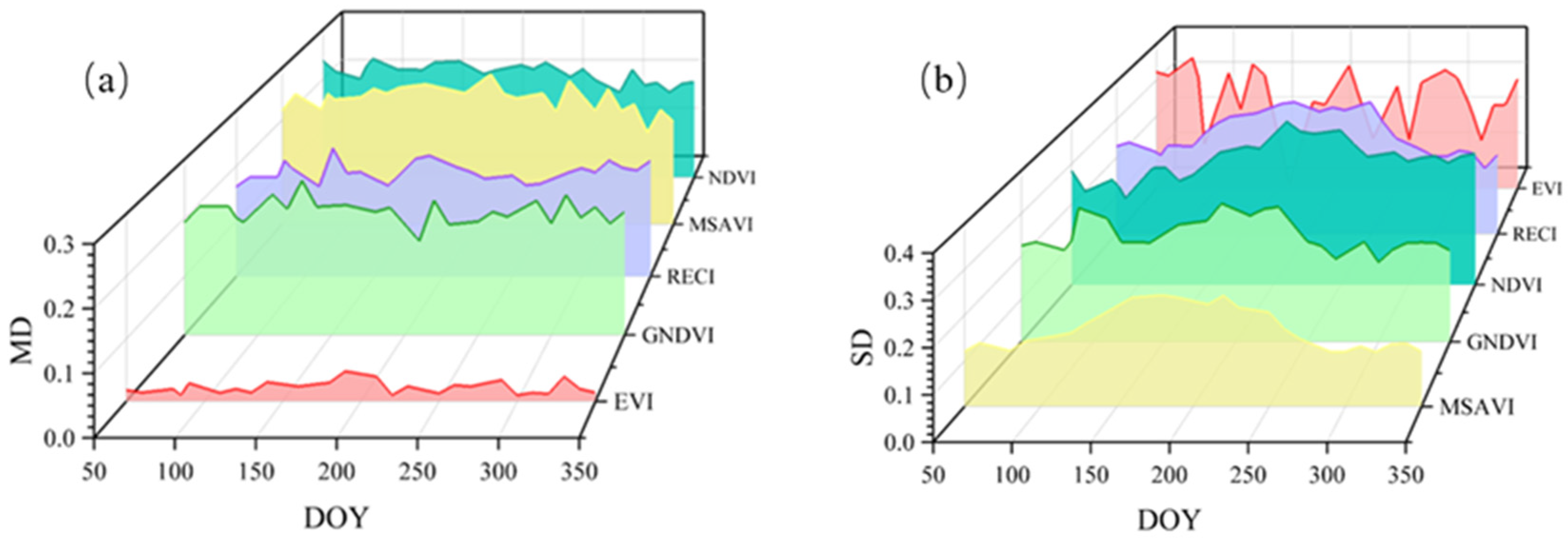

| Data Type | Time Coverage | Spatial Resolution | Data Source | Purpose | Preprocessing Steps |
|---|---|---|---|---|---|
| HLS | 1 January–30 December 2020 | 30 m | NASA (https://hls.gsfc.nasa.gov/ accessed on 12 September 2024) | Time series vegetation monitoring | Mosaicking, clipping and QA filtering |
| GLC_FCS30-2020 | 2020 | 30 m | CASEarth (https://data.casearth.cn/dataset/6523adf6819aec0c3a438252 accessed on 12 August 2024) | Land cover classification | ready-to-use classification product |
| Soil Water Content | 1 January–30 December 2020 | 1 km | TPDC (https://data.tpdc.ac.cn/zh-hans/data/49b22de9-5d85-44f2-a7d5-a1ccd17086d2 accessed on 28 December 2024) | Analysis of hydrological influence on phenology | Spatial resampling and temporal alignment |
| Vegetation Index Calculation Formula | Description |
|---|---|
| EVI accounts for the effects of atmospheric scattering and surface reflectance, enhancing its sensitivity to vegetation cover in areas with high vegetation density as well as in arid and semi-arid regions [29]. | |
| GNDVI is an indicator of the photosynthetic activity of vegetation and is commonly used to assess the water content and nitrogen concentration in plant leaves based on multispectral data without extreme red channels [30]. | |
| RECI is an efficient vegetation index that utilizes the spectral characteristics of the red-edge region. It shows a high sensitivity and linear relationship with leaf chlorophyll content, reduces the effects of background and canopy structure, and is less prone to saturation in areas with high biomass [31]. | |
| MSAVI is an index proposed to address the issue of soil background interference in vegetated areas. By introducing a soil adjustment factor, it effectively reduces soil noise [32]. | |
| NDVI is an important parameter for detecting vegetation growth status and mitigating certain radiometric errors. It reflects the background influences on the plant canopy, such as soil, wet surfaces, snow, dead leaves, and surface roughness [33]. |
Disclaimer/Publisher’s Note: The statements, opinions and data contained in all publications are solely those of the individual author(s) and contributor(s) and not of MDPI and/or the editor(s). MDPI and/or the editor(s) disclaim responsibility for any injury to people or property resulting from any ideas, methods, instructions or products referred to in the content. |
© 2025 by the authors. Licensee MDPI, Basel, Switzerland. This article is an open access article distributed under the terms and conditions of the Creative Commons Attribution (CC BY) license (https://creativecommons.org/licenses/by/4.0/).
Share and Cite
Zhao, Y.; Ren, S.; Tang, Y. Quantifying Mining-Induced Phenological Disturbance and Soil Moisture Regulation in Semi-Arid Grasslands Using HLS Time Series. Land 2025, 14, 2011. https://doi.org/10.3390/land14102011
Zhao Y, Ren S, Tang Y. Quantifying Mining-Induced Phenological Disturbance and Soil Moisture Regulation in Semi-Arid Grasslands Using HLS Time Series. Land. 2025; 14(10):2011. https://doi.org/10.3390/land14102011
Chicago/Turabian StyleZhao, Yanling, Shenshen Ren, and Yanjie Tang. 2025. "Quantifying Mining-Induced Phenological Disturbance and Soil Moisture Regulation in Semi-Arid Grasslands Using HLS Time Series" Land 14, no. 10: 2011. https://doi.org/10.3390/land14102011
APA StyleZhao, Y., Ren, S., & Tang, Y. (2025). Quantifying Mining-Induced Phenological Disturbance and Soil Moisture Regulation in Semi-Arid Grasslands Using HLS Time Series. Land, 14(10), 2011. https://doi.org/10.3390/land14102011






